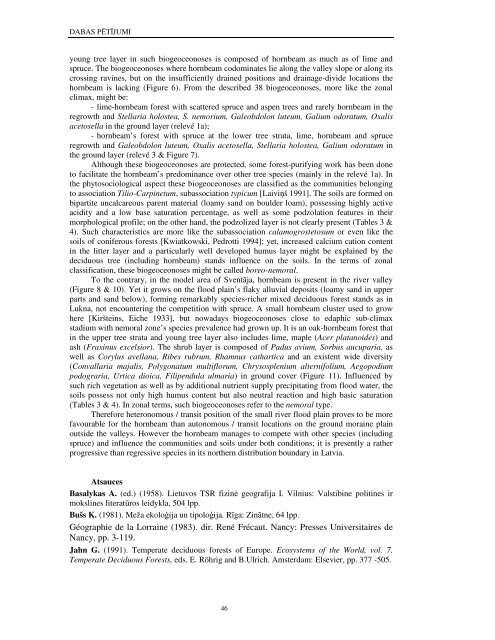Folia Geographica 10. sÄjums - Latvijas UniversitÄte
Folia Geographica 10. sÄjums - Latvijas UniversitÄte
Folia Geographica 10. sÄjums - Latvijas UniversitÄte
You also want an ePaper? Increase the reach of your titles
YUMPU automatically turns print PDFs into web optimized ePapers that Google loves.
DABAS PĒTĪJUMIyoung tree layer in such biogeoceonoses is composed of hornbeam as much as of lime andspruce. The biogeoceonoses where hornbeam codominates lie along the valley slope or along itscrossing ravines, but on the insufficiently drained positions and drainage-divide locations thehornbeam is lacking (Figure 6). From the described 38 biogeoceonoses, more like the zonalclimax, might be:- lime-hornbeam forest with scattered spruce and aspen trees and rarely hornbeam in theregrowth and Stellaria holostea, S. nemorium, Galeobdolon luteum, Galium odoratum, Oxalisacetosella in the ground layer (relevé 1a);- hornbeam’s forest with spruce at the lower tree strata, lime, hornbeam and spruceregrowth and Galeobdolon luteum, Oxalis acetosella, Stellaria holostea, Galium odoratum inthe ground layer (relevé 3 & Figure 7).Although these biogeoceonoses are protected, some forest-purifying work has been doneto facilitate the hornbeam’s predominance over other tree species (mainly in the relevé 1a). Inthe phytosociological aspect these biogeoceonoses are classified as the communities belongingto association Tilio-Carpinetum, subassociation typicum [Laiviņš 1991]. The soils are formed onbipartite uncalcareous parent material (loamy sand on boulder loam), possessing highly activeacidity and a low base saturation percentage, as well as some podzolation features in theirmorphological profile; on the other hand, the podzolized layer is not clearly present (Tables 3 &4). Such characteristics are more like the subassociation calamogrostetosum or even like thesoils of coniferous forests [Kwiatkowski, Pedrotti 1994]; yet, increased calcium cation contentin the litter layer and a particularly well developed humus layer might be explained by thedeciduous tree (including hornbeam) stands influence on the soils. In the terms of zonalclassification, these biogeoceonoses might be called boreo-nemoral.To the contrary, in the model area of Sventāja, hornbeam is present in the river valley(Figure 8 & 10). Yet it grows on the flood plain’s flaky alluvial deposits (loamy sand in upperparts and sand below), forming remarkably species-richer mixed deciduous forest stands as inLukna, not encountering the competition with spruce. A small hornbeam cluster used to growhere [Kiršteins, Eiche 1933], but nowadays biogeoceonoses close to edaphic sub-climaxstadium with nemoral zone’s species prevalence had grown up. It is an oak-hornbeam forest thatin the upper tree strata and young tree layer also includes lime, maple (Acer platanoides) andash (Fraxinus excelsior). The shrub layer is composed of Padus avium, Sorbus aucuparia, aswell as Corylus avellana, Ribes rubrum, Rhamnus cathartica and an existent wide diversity(Convallaria majalis, Polygonatum multiflorum, Chrysosplenium alternifolium, Aegopodiumpodograria, Urtica dioica, Filipendula ulmaria) in ground cover (Figure 11). Influenced bysuch rich vegetation as well as by additional nutrient supply precipitating from flood water, thesoils possess not only high humus content but also neutral reaction and high basic saturation(Tables 3 & 4). In zonal terms, such biogeoceonoses refer to the nemoral type.Therefore heteronomous / transit position of the small river flood plain proves to be morefavourable for the hornbeam than autonomous / transit locations on the ground moraine plainoutside the valleys. However the hornbeam manages to compete with other species (includingspruce) and influence the communities and soils under both conditions; it is presently a ratherprogressive than regressive species in its northern distribution boundary in Latvia.AtsaucesBasalykas A. (ed.) (1958). Lietuvos TSR fizinė geografija I. Vilnius: Valstibine politines irmokslines literatūros leidykla, 504 lpp.Bušs K. (1981). Meža ekoloģija un tipoloģija. Rīga: Zinātne, 64 lpp.Géographie de la Lorraine (1983). dir. René Frécaut. Nancy: Presses Universitaires deNancy, pp. 3-119.Jahn G. (1991). Temperate deciduous forests of Europe. Ecosystems of the World, vol. 7.Temperate Deciduous Forests, eds. E. Röhrig and B.Ulrich. Amsterdam: Elsevier, pp. 377 -505.46
















